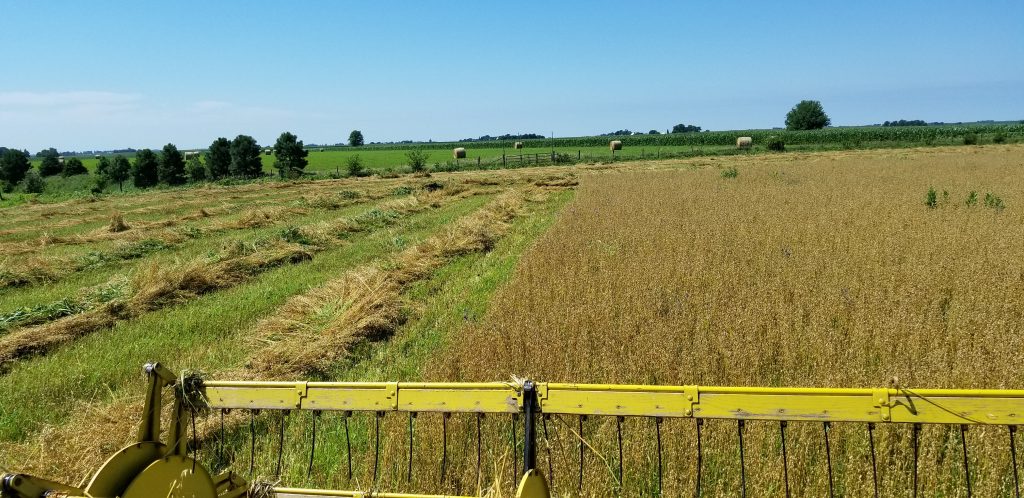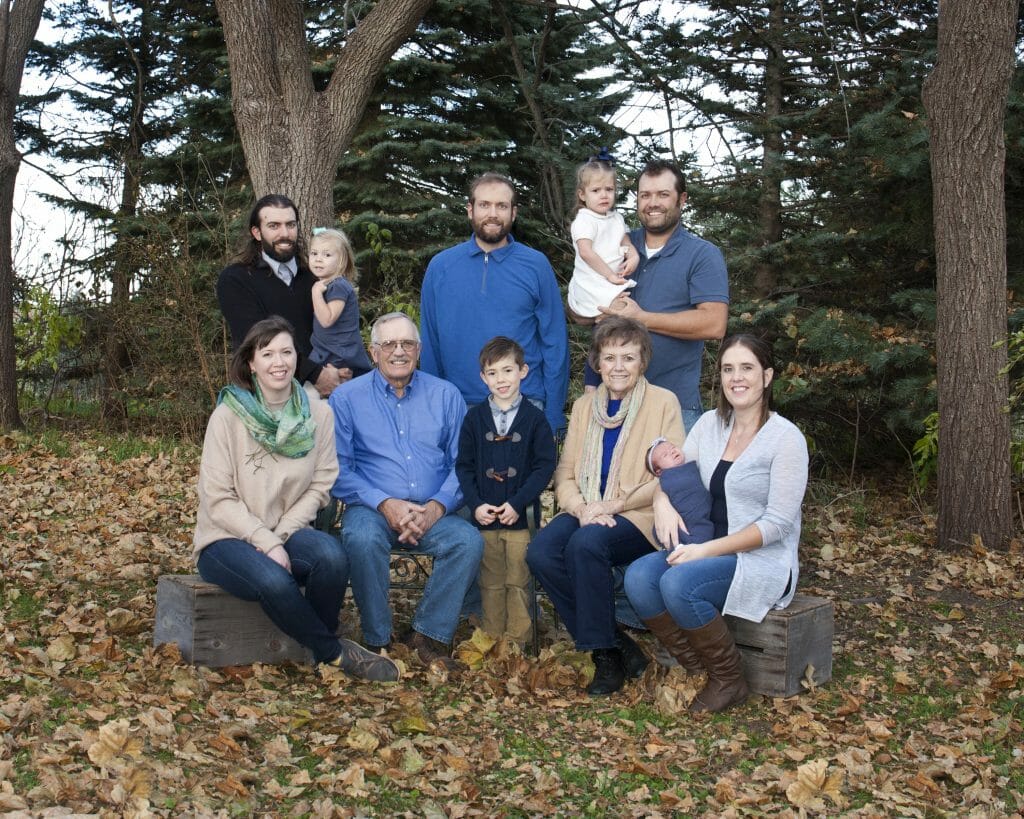Ron Rosmann’s 10 Tips for Growing Small Grains in Iowa
“This year is one of the worst small-grain growing years I have experienced in my 45 years of growing small grains,” Dan Wilson shared earlier this summer with fellow farmers on PFI’s field crops email discussion list.
Small grains love spring weather. This year, however, conditions in Iowa jumped from sub-zero temperatures and snow in mid-April – which delayed planting – to sweltering 80- and 90-degree heat in May. A deluge of rain carpeted much of the state, and unseasonally hot weather continued into June. This succession of adverse weather culminated in the perfect storm of bad conditions for small grains production, and led some farmers to muse: When was the last good year we had for small grains in Iowa – particularly oats? Can we even grow oats or other small grains successfully in today’s climate?

A view of wind-rowed oats at Rosmann Family Farm near Harlan.
Ron Rosmann and several other farmers weighed in with their experiences, challenges and advice. Ron farms with his family at Rosmann Family Farm near Harlan in Shelby County, in western Iowa. The farm has been certified organic for 24 years and has had good success growing oats. “We can say that we get good, consistent yields of 80-100 bushels per acre on average,” Ron said. “We had record oats [in 2017] with 145 bushels per acre on average and 41-pound test weight.” This year, he shared later, “we only yielded 70 bushels per acre due to the awful weather. But our test weight was still 39 pounds per bushel.” While acknowledging this year’s uniquely poor conditions, he shared 10 observations he has made over the years about growing a successful small grains crop in Iowa. Other farmers added their perspective and commented on the less tangible benefits small grains confer to a cropping system.
- Plant Early
“We always plant as early as we possibly can,” Ron said. Of course, it’s not easy to do every year for spring small grains like oats. “This year we managed to get some in on March 30 and 31, and the rest by April 12.” - Get the Right Seeding Rate
Ron makes sure he has a good carpet of small grains on the field to ensure a quality stand capable of suppressing weeds. “We always plant at 4 bushels or more per acre, sometimes even at five.” - Rotation, Rotation, Rotation
“Oats do better nearly always after soybeans in the rotation,” Ron said. “Whenever we go to oats after corn in the hay-corn-soy-corn-oats rotation, we lose key nitrogen to get good oats.” - Use It as a Nurse Crop
Even though Ron’s small-grain harvest has been variable the past several years, he gets an additional benefit from it: he plants oats and succotash alongside alfalfa, red clover and orchard grass. That so-called “underseeded” mix will slowly grow beneath the canopy of the fast-growing small-grain, helping to control weeds. The mix also supplies additional forage or grain for income in the same crop rotation year that will go to hay, pasture or green manure for the following year’s crop. “We still use oats as a nurse crop to establish alfalfa seeding in our organic operation,” confirmed Kim Anderson, who farms near Brighton. - Keep Them Dry
“Oats do not like wet feet,” Ron said. “I think they are harder to grow on land that historically has been wetlands and marsh, and colder and wetter.” Wade Dooley farms near the Iowa River close to Albion, and is familiar with how flooding and wetness can affect an oat crop. He strategically chooses his fields for small grains with this in mind. “In the 80s and 90s, we had minor flooding every three years or so on bottomland. But the last 12 years, [this land] has had major flooding every single year, with one or two exceptions,” Wade said. “I’ll never plant small grains on that land, even though it’s over 50 percent of my crop acres. Small grains get planted on upland, which puts the crop at a higher risk of drought – but I usually expect the drought to come during the harvest window, which doesn’t hurt the small grains.” - Use Strategically to Combat Problem Weeds
For organic farmers especially, controlling weed populations is a high priority. Even conventional farmers struggle today with herbicide-resistant weeds, which require an alternative strategy to control their spread throughout the field and farm. “We have one terrible 17-acre field where the rotation and soil fertility has been lacking,” Ron said. “Giant ragweed is also a bad problem there. We hope to do more rotations starting with hybrid winter rye, which we are going to start using in hog and chicken feed.” - Consider Switching From a Spring to a Winter Variety
“I try to avoid spring-seeded small grains except as a nurse crop for alfalfa,” shared Paul Mugge, who farms near Sutherland. “It seems like the risk is just too high any more for light test weight in oats, oat diseases due to high humidity, vomitoxin in barley, etc. I have had really good luck with fall triticale. I’ve only had it winter-kill here in northwest Iowa once in 15 years or so. I was really worried about our most recent brutal winter, but it did okay. The stand is a little weak, but not a disaster.” A winter small-grain also takes the pressure off of early planting in the spring and lowers the soil’s vulnerability to erosion and loss of organic matter because it keeps the soil covered all winter long. - Adapt to Local Variety Trial Data and Variety Availability
“Maybe we’re growing the wrong varieties, maybe the wrong species for our areas?” Wade questioned. “One of the varieties of rye I’ve got, I’m pretty impressed with. I’ve had several oat varieties I wasn’t so enamored of. I feel like maybe we need to be testing more of the Illinois varieties, rather than the North Dakota or Minnesota ones. [We have] lots of heat and humidity here in Iowa, similar to Illinois.” Ron and Kim both like oat varieties Shelby 427 and Deon, and their farms are located at or below I- 80 in far western and eastern Iowa, respectively.
Ron agreed that variety selection and availability of good breeding lines are key elements of success. “We quit growing just straight barley about 10 years ago, as we started to not be able to find the varieties that would yield like we used to have.” - Consider a Variety of Tillage Practices
For Ron and his family, preserving as much carbon in the soil as possible is a big goal. But he added: “I still think one year of mold-board plowing out of five or six is not such an evil thing as some people would like you to believe, if you are using cover crops and keeping the ground green most of the other years with small grains, hay and pasture.” So for those conscious of improving soil health and preventing soil erosion, rotations that incorporate small grains and cover crops can help balance out some periodic tillage in the system.
For an innovative farmer, small grains can also present opportunities to further no-till practices. Ron has been ridge-tilling his corn and soybeans since 1987 for weed control in his organic system, but he’s scheming to reduce his tillage even further. “I want to experiment with less alfalfa and more annual forages after winter rye and oats that will winter-kill,” Ron said. “Then I can no-till corn the following year without disturbing the soil. This would be done in a flat no-till organic situation. This is going to take some trial and error, and I hope we can find the time to do it.” - Know Your Goals
“You first have to figure out what your goal is and what the value of oats is to your operation,” Ron said. If getting the most bushels per acre is your main goal, then maybe small grains aren’t a viable crop for you in today’s climate with the varieties we have today. But if your goal is a diverse system, non-chemical weed control and more options to till and no-till while preserving soil health, then small-grains crops may be an ideal addition to your crop rotation plan.

The Rosmann family gathered in October to celebrate Ron and Maria’s 40th anniversary. Top row, from left to right: Daniel Rosmann, Geneva Rosmann, Mark Rosmann, Maggie Rosmann and David Rosmann; bottom row, from left to right: Ellen Walsh-Rosmann, Ron Rosmann, Xavier Rosmann, Maria Vakulskas Rosmann and Becky Tompkins-Rosmann (holding newborn Ellie Rosmann).
